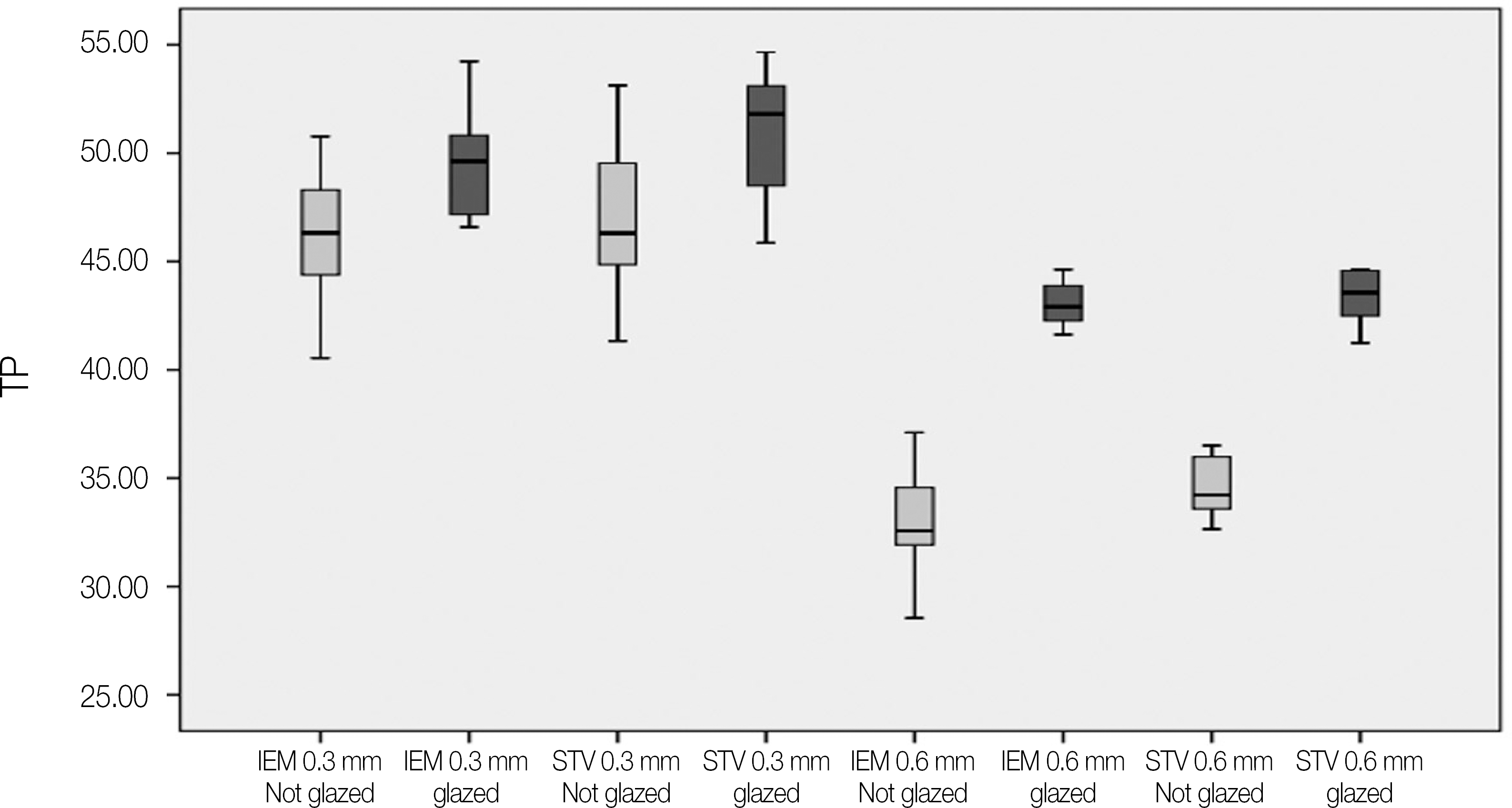Abstract
Purpose
The aim of this study was to compare the translucency of two different laminate ceramic veneers with and without glazing.
Materials and methods
Ten millimeter side square-shaped specimens in 0.3 mm and 0.6 mm thick were fabricated for the following materials with and without glazing (n=80): A1 shade IPS e.maxPress (IEM) and Styleveneers (STV). The color coordinates (CIE L∗ a∗ b∗) of the specimens were measured with a colorimeter. The Translucency parameter (TP) was calculated from the color difference of the material on a black versus a white background. For comparisons between materials and between the ‘not glazed’ and ‘glazed’ groups, unpaired t-test was used to analyze the data (P=.05).
Results
The TP (Mean ± SD) of ‘not-glazed’ and ‘glazed’ group of IEM specimens at 0.3 mm thickness were 45.99 ± 3.00 and 49.53± 2.28 and the TP at 0.6 mm thickness were 32.82 ± 2.59 and 43.02±0.98, respectively. Likewise, the TP of ‘ not-glazed’ and ‘ glazed’ group of STV specimens at 0.3 mm thickness were 47.03 ± 3.65 and 50.95 ± 3.05 and the TP at 0.6 mm thickness group were 34.48 ± 1.28 and 43.39 ± 1.20, respectively. As the glazing of ceramicveneer differed, the TP of each ceramic veneer showed statistically significant difference. But, the result between the products was not statistically different.
Go to : 
REFERENCES
2. Yilmaz K, Gonuldas F, Ozturk C. The effect of repeated firings on the color change of dental ceramics using different glazing methods. J Adv Prosthodont. 2014; 6:427–33.

3. Barizon KT, Bergeron C, Vargas MA, Qian F, Cobb DS, Gratton DG, Geraldeli S. Ceramic materials for porcelain veneers: part II. Effect of material, shade, and thickness on translucency. J Prosthet Dent. 2014; 112:864–70.

4. Yilmaz C, Korkmaz T, Demirkö prü lü H, Ergü n G, Ozkan Y. Color stability of glazed and polished dental porcelains. J Prosthodont. 2008; 17:20–4.
5. Wiskott HWA. Fixed prosthodontics: principles and clinics. London: Quintessence publishing Co. Ltd;2011. p. 670–1.
6. Choi BB, Woo YH. Contemporary fixed prosthodontics. 3rd ed.Seoul: Jisung;2003. p. 645.
7. Chu FC, Chow TW, Chai J. Contrast ratios and masking abili-ty of three types of ceramic veneers. J Prosthet Dent. 2007; 98:359–64.

8. Baek KW, Kim SJ. Thickness and translucency of opaque shade composite resin for masking effect. J Korean Dent Assoc. 2011; 49:203–10.
9. Sinmazisik G, Demirbas B, Tarcin B. Influence of dentin and core porcelain thickness on the color of fully sintered zirconia ceramic restorations. J Prosthet Dent. 2014; 111:142–9.

10. Heffernan MJ, Aquilino SA, Diaz-Arnold AM, Haselton DR, Stanford CM, Vargas MA. Relative translucency of six all-ceramic systems. Part II: core and veneer materials. J Prosthet Dent. 2002; 88:10–5.

11. Spear F, Holloway J. Which all-ceramic system is optimal for anterior esthetics? J Am Dent Assoc. 2008; 139:19S–24S.

12. Obregon A, Goodkind RJ, Schwabacher WB. Effects of opaque and porcelain surface texture on the color of ceramometal restorations. J Prosthet Dent. 1981; 46:330–40.

13. British standard specification for dental porcelains for jacket crowns. BS5612. London: British Standard Institution;1978.
14. Johnston WM, Ma T, Kienle BH. Translucency parameter of colorants for maxillofacial prostheses. Int J Prosthodont. 1995; 8:79–86.
15. Ryu SY, Lim JH, Cho IH. A study on the color stability of porcelain for porcelain fused to metal crown. J Korean Acad Prosthodont. 2000; 38:73–84.
16. Chung IS, Lee DC. Effect of surface treatments and glazing temperatures on bond strength and color reproducibility in titanium-ceramic prosthesis. J Korea Content Assoc. 2010; 10:243–50.

17. Kelly JR. Dental ceramics: what is this stuff anyway? J Am Dent Assoc. 2008; 139:4S–7S.
18. Etman MK. Confocal examination of subsurface cracking in ceramic materials. J Prosthodont. 2009; 18:550–9.

19. Guazzato M, Albakry M, Ringer SP, Swain MV. Strength, fracture toughness and microstructure of a selection of all-ceramic materials. Part I. Pressable and alumina glass-infiltrated ceramics. Dent Mater. 2004; 20:441–8.

20. Cattell MJ, Knowles JC, Clarke RL, Lynch E. The biaxial flexural strength of two pressable ceramic systems. J Dent. 1999; 27:183–96.

21. Rugh EH, Johnston WM, Hesse NS. The relationship between elastomer opacity, colorimeter beam size, and measured colorimetric response. Int J Prosthodont. 1991; 4:569–76.
Go to : 
Table 1.
Experimental materials and glazing agents investigated
Table 2.
TP values and t-test results of materials with/without glazing in 0.3 mm and 0.6 mm thickness
Table 3.
TP values and t-test results between materials in 0.3 mm and 0.6 mm thickness




 PDF
PDF ePub
ePub Citation
Citation Print
Print



 XML Download
XML Download